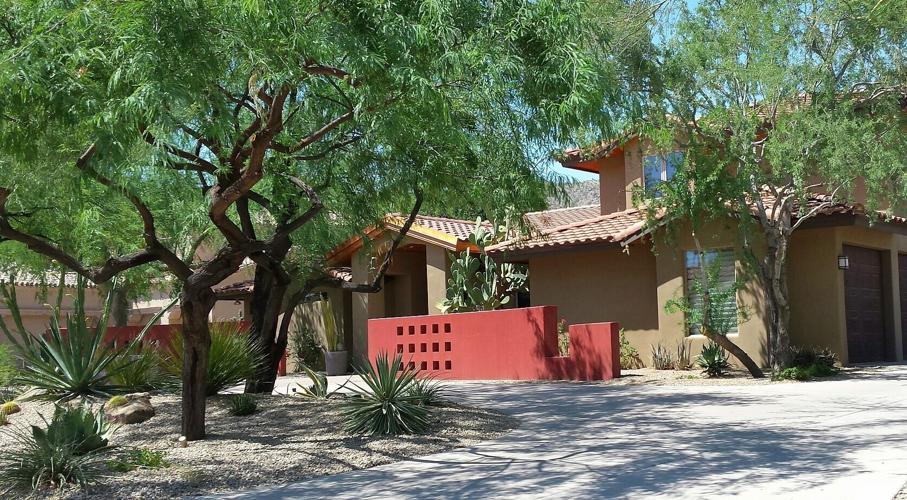Planting trees in the fall months works well with the higher climate zones. The lower or desert zonesŌĆÖ planting season extends all the way to March.
Before planting, take the time to select a tree variety that adapts well to your climate zone. Choosing native trees is a safe bet, but many others can thrive in the Arizona desert if planted correctly.
The steps
1. The first step is selecting the right tree for the right place in your yard. to one of our previous discussions (rosieonthehouse.com/diy/what-trees-should-i-plant-in-my-yard). Our DIY guide this week will build on that and discuss the important steps you will need to take to ensure your perfectly selected and placed tree thrives and does all the things you want it to.
People are also reading…

2. Dig a hole. This may seem like an obvious statement, but it marks the beginning of one of the most critical steps. To be sure we tell you right, we talked with farmer Greg Peterson of Urban Farm to get solid information about this formative second step.
- Dig a square hole about two feet wide by two feet wide, or at least two times as wide as the root ball in the container you bought the tree in, and make the hole about a foot deep, or at least as deep as the root ball from the container.
- By digging a square hole, the roots will grow in a pattern that allows them more freedom to engage the surrounding native soil and not continue to grow in the circular ball-like configuration.
3. You should gently loosen some of the roots from a tight root ball to encourage expansion into your yardŌĆÖs soil. Sometimes the tree roots will experience root girding while in the container. Girding occurs when the roots of the root ball have been in a circular container for a period and have adopted a circular configuration.
- Place the tree in the freshly dug hole. Find where the tree trunk meets the first sprout of roots. This should be about even with, or slightly higher than, the surrounding grounds surface. It can be placed a little higher, by an inch or two at most.
- Backfill the hole with native soil you dug from the hole while maintaining the trunk elevation. Take care to compact the soil well enough to maintain the root ballŌĆÖs position but not so much as to make the rootsŌĆÖ future growth too constricted.
- Create a water well by digging a small pond around the base of the tree to hold water. Then, build a berm of about 3ŌĆØ to 4ŌĆØ in height that surrounds the tree. The diameter of this well should be about where the treeŌĆÖs drip line would be. If it is a very young sapling, you should make it about two feet in diameter at a minimum.

4. Stake the tree. This task can be tricky, and if not done correctly, it will stifle the treeŌĆÖs growth. If a tree is too young or its trunk is too skinny to withstand the winds in your yard, consider putting stakes around it with tethers for support. Stakes can be steel or wood, and two are probably sufficient.
- Use at least two or three stakes placed just outside the water well, driven firmly into the ground. Penetration of a foot to a foot and a half is best.
- Tying the treeŌĆÖs trunk to the stakes needs careful attention. Tie them loosely but firmly.
- Use a wire or synthetic twine tie that is tightly tied to the stake.
- Use a plastic tube, such as ┬ŠŌĆØ irrigation tubing or an old piece of hose, thread the twine through the tube, and place that loop loosely around the trunk of the tree. This method will allow the tree to move and grow in trunk girth without the supporting mechanism growing into the tree.
5. Applying mulch about two to three inches deep in the water well is beneficial in several ways. One, it helps keep moisture in the ground so the roots stay moist. Mulch is also a good form of temperature control. In the warmer climates of Arizona, it helps keep the roots cool. Also, in cooler climates, mulch helps keep in the heat.
6. It is important to water slowly and deeply.
- Let the water seep into the ground, saturating the root ball and the surrounding soil. By watering slowly, like the garden hose on a healthy trickle, you allow the water to seep into the ground before filling the water well you created.
7. Monitor your young tree.
- Watch the tree during a windy afternoon to see if the stakes you put in are working well. They should allow the tree to move a few inches in any direction, but keep the movement restricted to prevent the trunk from bending severely.
- Look at the leaves on the tree for telltale signs of under-watering. Also, check the flexibility of the tender branches to ensure they are not brittle.
Trees are a wonderful addition to our landscape, providing shade and privacy. Taking care with these initial steps can ensure your new tree is off to a great start.
DonŌĆÖt be shy about consulting with your local nursery for tips on feeding and caring for your tree as it grows.
Join Rosie on the House every Saturday morning 8-11 on KTAR 92.3 FM and KNST 790 AM from 10-11 a.m.
Do you have questions about your house, home, castle or cabin? Reach us by phone at 1-888-767-4348 or email info@rosieonthehouse.com. Follow us on Facebook, YouTube, and Instagram.










